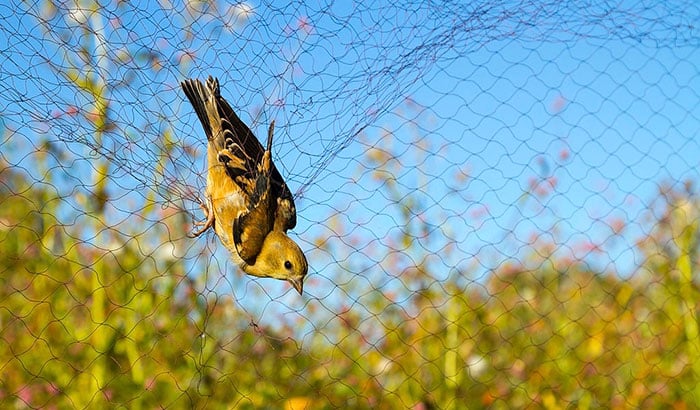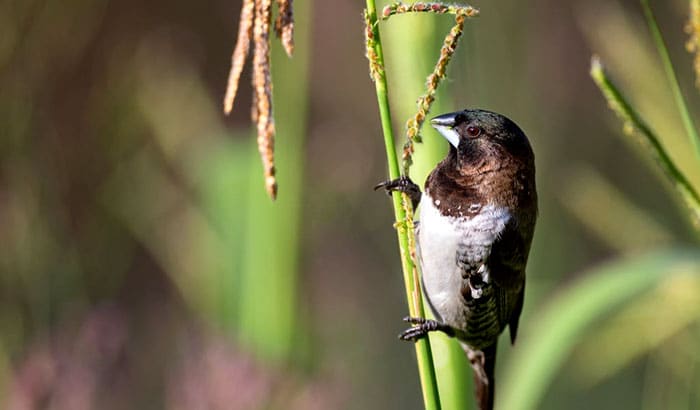Have you tried sowing grass seed and have nothing to show for it? Of course, there are many causes for such results, but one of the most probable is that birds ate the grass seed. Fortunately, you can quickly learn how to protect grass seed from birds using different tools like repellent nets or burlap sheets.
Birds feed on many types of seeds, including grass. Sown grass seed makes for an excellent food source for birds. This post will teach you the different measures you can take to keep birds away from the grass seed you sow.
Contents
How to Keep Birds from Eating Grass Seed
Most of the tips I can give you require special devices. Be ready to spend a little money if you want to save your grass seed from being bird food.
Make the Seeds Unreachable
One of the most effective methods on how to keep birds from eating grass seed is to make the seeds unreachable. I suggest you use items like repellent nets or burlap sheets to cover the area where you raked in the grass seed. These items allow water and sunlight to penetrate them and reach the grass seed.
If you choose to lay a net, I advise using polyurethane repellent nettings because they are lightweight and not prone to mold or mildew.
Secure the net or burlap sheet to the ground either by using stakes, pins, wires, stones, or anything that will make them unsusceptible to blowing winds. You can lay the cover directly on the ground or raise it just a few inches off the ground. I advise lifting it to a few inches off the floor so the birds can’t peck through them and reach the seeds.
You need only keep the protective cover on top of the sown while the seed germinates. It is safe to remove the covers once the grass sprouts, which only takes 5 to 10 days after planting.
Lay Down Mulch
If you are going to protect the seeds, why not do it so that you are also benefitting them? Laying down mulch protects the grass seed from pecking avians and weeds while also giving the seeds the perfect conditions for growth.
Straw mulch is the best option here because it is light. It will allow heat, sunlight, and moisture to reach the seeds. Just be sure to cover around 75% of the ground so that it can still get nutrients conducive to plant growth.
The mulch must be weed-free. Sow the seeds about ⅛ of an inch deep into the soil and layer the mulch on top. There is no maintaining needed because mulch is a natural cover; you need only remove it carefully after the seeds have germinated.
Scare the Birds Away
If all you care about is the grass seed, scaring the birds away is probably a good option for you. If you don’t mind not having birds around your garden, using tools that scare birds away should suit your needs.
Using tools like fake predators, predatory sounds, or motion-activated bird deterrent sprinklers will effectively prevent birds from getting to your property. Fake owl or hawk figures will scare songbirds that generally prey on helpless seeds. But be sure to move the figures regularly so that the birds won’t become any the wiser about this particular trick.
Predatory sounds might include the calls of predators or the sound of their flapping wings. One tidbit I found impressive regarding the use of sounds to deter small birds is to use the sound of a moving locomotive. Apparently, a moving steam locomotive has a similar sound pattern to an owl in flight.
The motion-activated bird repellent sprinkler is a good tool because it deters birds while also watering your plants. You are hitting two birds with one stone (or water sprinkler).
Set Decoy Feeders
Whenever someone asks me how to stop birds from eating grass seed, this method is the very first thing that pops into my mind. Setting up decoy feeders is my favorite option because it protects the grass seed while providing something for the birds.
The birds go through a lot of trouble trying to reach the grass seed buried under the soil. They probably have to dig for each tiny seed before pecking at it. But if you provide them a feeder where they can feed without worrying about digging, they would leave the grass seed alone.
However, you have to ensure that the feeder is away from the area where you planted the grass seed. If the feeder is too near the seeds, the birds might go for them if there’s too much competition around the feeder.
My advice is to combine two tips I mentioned here: laying down a cover and setting up a feeder.
If you’re going to cover the grass seed, you might just as well use a mulch to provide the best conditions for the seeds.
Conclusion
Now you know how to protect grass seed from birds. There are many methods, but I advise laying down mulch on top of the seeds and setting feeders away from them. These two techniques benefit both the grass seed and the birds because you are providing for both of them this way.


